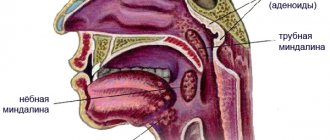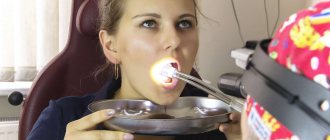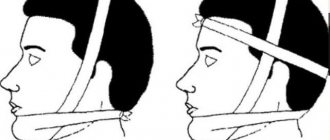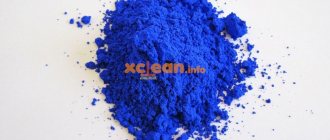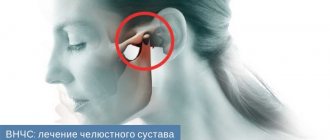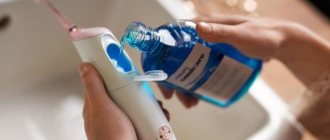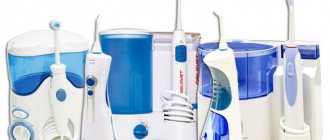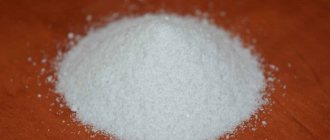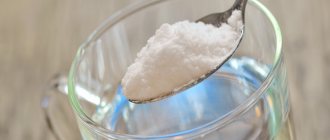01/18/2022
86 510
17 minutes
Co-author, editor and medical expert – Maksimov Alexander Alekseevich.
- Symptomatic treatment
- Rinsing
Many people are familiar with the diagnosis of tonsillitis. This unpleasant disease can take you by surprise and prevent you from leading a normal life. Tonsillitis is a pressing problem today, as it can occur at any age and with various diseases, such as herpes, diphtheria, streptococcal infections, scarlet fever and others. Often tonsillitis (or simply tonsillitis) acts as an independent disease. To understand the diagnosis and begin proper treatment, you need to consult a doctor. Remember that self-medication can lead to complications. What is tonsillitis? And how to cope with this disease? We will consider the answers to these questions below.
Up to contents
Is it possible to wash tonsils with an irrigator?
In this article
- Is it possible to wash tonsils with an irrigator?
- Why rinse your tonsils?
- Is it possible to rinse tonsils with an irrigator?
- Flushing the tonsils with an irrigator
- How to rinse tonsils at home with an irrigator
- When is tonsil flushing contraindicated?
- Basic recommendations: how to properly rinse tonsils at home
First, a few words about tonsils and tonsillitis. The human throat provides ideal conditions for the proliferation of fungi, viruses and bacteria. Tonsils (tonsils) protect the respiratory system from pathogenic microorganisms. They have microscopic lacunae into which food debris, dead epithelial cells and microbes fall. Tonsils are an important part of the body's immune system; they protect the lungs from infectious diseases, but at the same time become vulnerable to disease. A viral or bacterial inflammatory process in the lacunae of the tonsils causes chronic tonsillitis - a long-term inflammatory process of the pharyngeal or palatine tonsils.
This pathology can cause a person many problems, causing bad breath, fatigue, pain and sore throat. In addition, tonsillitis can cause tonsillitis and other complications. Treatment of this disease is carried out by an otolaryngologist. He prescribes a course of antibiotics and drugs for washing the tonsils.
Why carry out the procedure
Washing the tonsils allows you to get rid of accumulations of pus and pathogenic bacteria, which make inflammatory diseases of the throat very difficult to cure.
The procedure allows not only to speed up recovery and restore the normal state of the tonsils, but also to prevent further spread of the infection, which can cause a retropharyngeal abscess, neck phlegmon, or even sepsis.
When washing the lacunae of the tonsils, it is possible to significantly reduce the treatment time. Thanks to this procedure, the following throat diseases go away faster:
- angina,
- tonsillitis,
- pharyngitis,
- laryngitis.
In addition to cleansing the tonsils from pus and bacteria, the procedure, if it uses not just water, but medications, also speeds up the restoration of the mucous membrane. Various rinses of the lacunae are the most effective ways to treat inflammation of the tonsils.
Why rinse your tonsils?
Washing of the tonsils is carried out taking into account the characteristics of this organ. The tonsils are a collection of lymphoid tissue, inside of which there are small cavities and passages. They quickly fill with food debris, saliva and plaque from the teeth, which subsequently cause tonsillitis. Its manifestations can be minimized by washing the tonsils. You should contact an ENT specialist, who will prepare an antibacterial solution and carry out the procedure with a syringe or irrigator. Doing this yourself at home is dangerous, it can damage the tissue and cause complications.
The doctor may prescribe a course of physiotherapeutic procedures, the duration of which is 5-10 sessions - it all depends on the degree of the disease. When washing the tonsils, foreign substances and pus are removed from the lacunae. After several procedures, the process of self-cleaning of the tonsils begins. To avoid injury to the tonsils during tonsillitis, they can only be washed in the otolaryngologist’s office. Rinsing for the purpose of prevention is carried out at home using oral irrigators.
Solutions for cleaning sore tonsils
To cleanse the tonsils, use pharmaceutical antiseptic drugs or prepare the products yourself. There are several reliable home solutions for treating tonsils.
- Saline solution. This medicine perfectly kills pathogenic bacteria and accelerates the regeneration of the mucous membrane.
- Soda solution. The medicine not only kills bacteria, but also softens the tissues and relieves swelling. Prepare a solution at the rate of: 1 tsp. soda per glass of water.
- A solution of soda with salt and iodine. The medicine has a very strong effect. For this, dissolve a teaspoon of soda and salt in a glass of water. Then 3 drops of iodine are added to the product.
The washing procedure can also be carried out with the following pharmaceutical preparations:
- Furacilin;
- Chlorophyllipt - it must be dissolved in a volume of 1 tsp. for 150 ml of water. In addition to the antiseptic effect, the composition helps relieve pain and irritation.
Both homemade and pharmaceutical preparations can be used for rinsing equally for children and adults. When carrying out the procedure, it is important to remember that all solutions must be warm.
Is it possible to rinse tonsils with an irrigator?
An oral irrigator is a device that, by supplying pulsating water, cleanses the teeth and gums of food debris. According to dentists, regular use of such devices helps prevent the development of caries, gingivitis, periodontitis and other dental diseases. The irrigator should be used as an additional hygiene product, along with a toothbrush and floss. You need to use it at least 2-3 times a week, and better yet, every evening after traditional teeth brushing.
Modern irrigators are multifunctional devices that are suitable for cleansing the oral cavity, massaging the gums and rinsing the tonsils. The device reservoir should be filled with plain water or a disinfectant solution, furatsilin and other products approved by a doctor and compatible with a specific device. Let's learn how to wash your tonsils at home using an irrigator.
Vacuum washing method
The vacuum method of rinsing using the Tonsillor apparatus is the most modern way to rinse the lacunae of the tonsils.
In simple terms, the nozzle of the Tonsillor device works on the principle of a vacuum cleaner. It is attached to the tonsil, the device creates negative pressure. The washing solution, passing through the lacunae of the tonsils, washes out their pathogenic contents, which, together with the waste solution, are sucked into a special cup of the nozzle. That is, the solution is used and passes through the tonsils only once, which confirms the sterility of the manipulation. Before washing, topical anesthesia of the tonsils is performed with lidocaine solution.
Despite the effectiveness of vacuum washing, this method is not without its drawbacks:
- it happens that the edges of the nozzle can injure the surface of the tonsil;
- The walls of the cup, where the washing solution that has passed through the tonsils is evacuated, is opaque, and the doctor cannot see whether the tonsils have been completely washed. As a result, the ENT doctor has to carry out additional procedures to certainly clear the lacunae.
A reasonable question arises: “Is washing the tonsils always associated with some risks?” No! There is another way to wash the tonsils - safe, effective and non-traumatic. This is the use of an improved Tonsillor attachment.
Flushing the tonsils with an irrigator
First you need to choose a suitable irrigator model. It can be portable or stationary, pulsed or microbubble. Portable models are not suitable for washing tonsils, as they have one significant drawback - the inability to smoothly switch the water supply mode. A sudden change in pressure and jet pressure can lead to tissue injury. Therefore, it is better to choose stationary models for washing the tonsils.
They are more functional and have several operating modes, including for cleaning gums and tonsils. In addition, stationary irrigators come with several nozzles, while portable ones are sold with one, or maximum two nozzles.
The minimum value of the cleaning jet pressure created by an irrigator suitable for washing tonsils should not be more than 150 kPa. Waterpik WP-108 E2 Ultra is ideal for this procedure - a stationary device that supplies pressure from 70 to 560 kPa. There is a lever on the handle for smooth switching of modes. You need to start the procedure with the weakest pressure, gradually increasing it. The device comes complete with 7 attachments. One of them is designed to clean gum pockets. It can also be used to wash the tonsils. Two standard attachments are also suitable for this.
Another suitable irrigator that can be used to wash tonsils is available under the brand name Aquapick AQ-300. It has several operating modes and 4 attachments included. The reservoir is quite large - 600 ml. It is enough for a complete cleaning for two or three family members. This device can be mounted on the bathroom wall using a bracket. It is not cheap, but it is one of the most functional. There is also a more budget option - B.Well WI-922. This device can be used to clear tonsils, but the minimum power it produces is 200 kPa. This irrigator is not suitable for children to wash their tonsils.
Our online store offers many stationary irrigators that can be used for washing tonsils. When purchasing, consider the following indicators: jet power, minimum pressure, number of operating modes, pulsation frequency and tank volume. Now we’ll find out how to rinse your tonsils with an irrigator at home.
How to rinse tonsils at home with an irrigator
It is better to rinse the tonsils on an empty stomach in the morning, since a stream of water entering the larynx can cause vomiting. Such reflexes cease to bother you after regular procedures. The duration of rinsing the tonsils is 2-3 minutes, but you can start from 30-40 seconds until slight discomfort appears in the throat. Washing is performed according to the following algorithm:
- stand in front of the mirror and take the irrigator handle;
- set the jet pressure to the minimum level;
- insert the tip of the device into your mouth and turn on the device;
- When changing the position of the device, turn it off each time.
Before washing, make sure the device is in working order. Fill the reservoir with a suitable solution.
Do not use decoctions and infusions. The smallest plant particles included in them can become clogged in the device’s filter and damage it.
After the procedure, you need to thoroughly clean the nozzle and put it in the case. When washing, do not swallow the solution, as it contains microbes washed out of the lacunae of the glands. Do not tilt your head back to prevent liquid from entering your respiratory tract.
After the procedure, you may feel dry mouth and sore throat. This is a normal reaction of the body to the solution used and the pulsation of the liquid. Subsequently, the larynx will get used to the effects of pulsating water. However, if you experience a sore throat and blood in your saliva, stop using the irrigator and consult a doctor. At home, only preventive cleaning of the tonsils is possible. For tonsillitis, you need to undergo the procedure in the ENT office.
Rinsing with a modified Tonsillor nozzle
This method of washing will not be offered to you in any of the clinics in Moscow, except for the ENT Clinic of Doctor Zaitsev! An improved, modified attachment for the Tonsillor apparatus was developed by the founder of the ENT clinic, Vladimir Mikhailovich Zaitsev, together with his colleagues. The operating principle of the new nozzle is absolutely the same as that of the classic nozzle. The difference is in its structure:
- the improved “Tonsillor” nozzle creates greater negative pressure, due to which rinsing the tonsils is much more effective and of better quality;
- the edges of the nozzle in contact with the tonsils do not cause damage or microtrauma;
- The cup of the nozzle into which the washing solution with the purulent contents of the lacunae is sucked in is transparent, and the doctor immediately sees at what point the procedure can be stopped. Thus, the patient does not undergo unnecessary manipulations.
- The size of the nozzle allows washing even for children.
It is necessary to rinse the tonsils only with the participation of an otolaryngologist. We do not recommend self-medication!
In order to forget about the symptoms of chronic tonsillitis for a long time, it is necessary to undergo a full comprehensive course of treatment of chronic inflammation, including, in addition to rinsing, drug therapy and physiotherapeutic procedures. This is the only way to preserve the tonsils and achieve stable remission!
When is tonsil flushing contraindicated?
The procedure is not recommended for people with arterial hypertension - there is a risk of a sharp increase in blood pressure. Also among the contraindications:
- acute infectious diseases of the gums, teeth and throat;
- increased body temperature;
- retinal pathologies and glaucoma;
- severe heart failure;
- 1st and 3rd trimesters of pregnancy;
- allergy to solutions used for rinsing.
Do not use faulty appliances. An irrigator can damage your gums and tonsils if the jet pressure is too strong. If the device does not work well, replace it.
Basic recommendations: how to properly rinse tonsils at home
Experts advise adhering to the following rules when washing your tonsils:
- choose only high-quality irrigators with several operating modes and the ability to regulate pressure;
- wash your tonsils to prevent tonsillitis if it has already been diagnosed once;
- carry out the procedure in courses of 5-10 procedures with intervals of several months;
- during the period of preventive treatment, avoid spicy and hard foods (crackers, chips, etc.), which can burn or scratch the larynx;
- After rinsing, gargle with an antiseptic solution.
What to do if it hurts after washing your tonsils
Most people experience pain after the procedure for washing the tonsils. They can be stored for up to three days. To eliminate discomfort, it is recommended to gargle with soda after rinsing the tonsils.
If the pain persists for more than three days, you should urgently visit a doctor.
Washing out gaps on your own is only possible if you are completely confident that you will be able to do everything correctly. It is unacceptable to take risks in this case, due to possible dangerous consequences.

